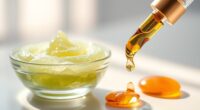Dry shampoo works by absorbing excess oil with ingredients like starch or baking soda, making your hair look cleaner temporarily. While it’s handy for quick fixes, it’s not a complete substitute for washing, and overuse can cause buildup, irritation, or clogged follicles. Ingredients, usage frequency, and hair type influence its safety and effectiveness. To learn more about how dry shampoo really impacts your hair and scalp, keep exploring these key facts.
Key Takeaways
- Dry shampoo uses absorbent powders like starch or baking soda to trap excess oil and refresh hair without water.
- It provides a temporary fix and cannot replace regular washing, which removes dirt, sweat, and buildup more thoroughly.
- Overuse can cause scalp irritation, buildup, and dull hair color over time, especially if applied excessively or on sensitive skin.
- Proper application and limited use help prevent dryness, damage, and buildup while maintaining scalp and hair health.
- Aerosolized particles pose inhalation risks, making ventilation and ingredient awareness important for safe use.
How Does Dry Shampoo Absorb Oil?
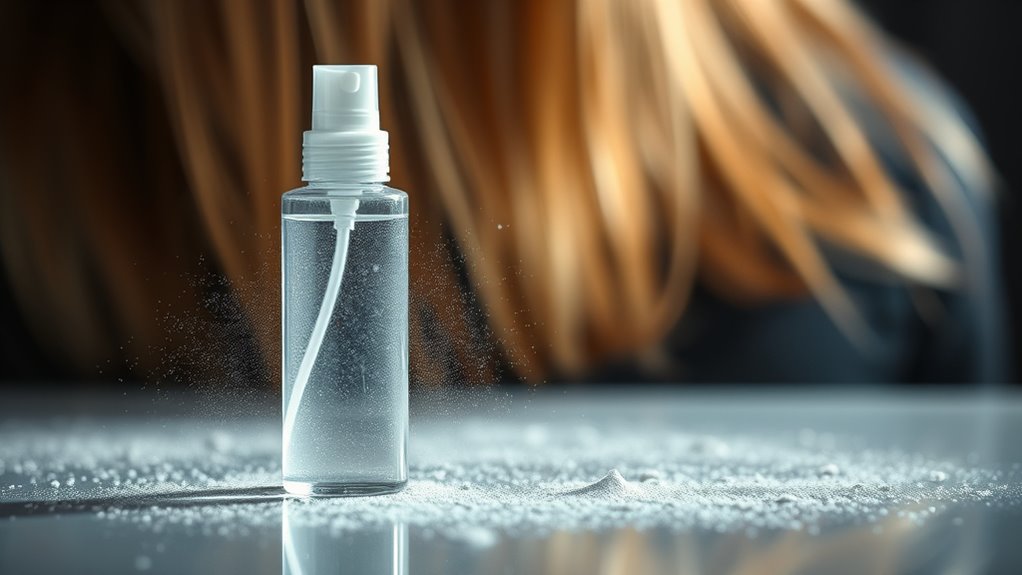
Dry shampoo works by using its absorbent ingredients to pull excess oil from your scalp and hair. Its powder mechanism involves tiny particles, like starch or baking soda, that trap oil on contact. When you spray or apply dry shampoo, these powders spread evenly across your scalp and hair strands. As you work it in, the powders absorb the oil through oil absorption, effectively removing greasy buildup. This process leaves your hair looking fresher and less weighed down. The key is the powder mechanism’s ability to quickly and efficiently soak up oil without needing water. That’s why dry shampoo is so popular for quick refreshes between washes. Just remember, its effectiveness depends on the powder’s ability to trap and hold onto excess oil through oil absorption. Additionally, understanding the science behind absorbent materials can help you choose the best dry shampoo formula for your hair type.
Is Dry Shampoo a Substitute for Washing Hair?

While dry shampoo can temporarily refresh your hair, it shouldn’t replace regular washing. Relying solely on dry shampoo might leave buildup, which can dull your hair color over time. Additionally, frequent use may cause scalp irritation or clogged hair follicles. Although dry shampoo reduces water use, it still has an environmental impact, especially if it contains aerosol propellants or non-biodegradable ingredients. It’s best to use dry shampoo sparingly and alongside traditional washing to maintain scalp health and preserve your hair color’s vibrancy. Regular shampooing removes oils and dirt more thoroughly, preventing potential damage caused by excess product buildup. Furthermore, understanding the core personality traits of your hair and scalp can help tailor a more effective hair care routine. Think of dry shampoo as a quick fix, not a substitute for proper hair cleansing and care.
Are There Any Risks Associated With Dry Shampoo Use?

Using dry shampoo can sometimes cause scalp irritation or build-up if not used properly. You might also be concerned about inhaling particles, especially with frequent use. It’s important to understand these potential risks to keep your hair and health safe. Additionally, being aware of proper application techniques can help minimize these issues and maintain the benefits of dry shampoo. Proper application techniques
Scalp Irritation Potential
Although dry shampoo offers a quick solution for greasy hair, some users worry about scalp irritation. If you have sensitive skin, you might notice discomfort or redness after applying dry shampoo. This is often due to scalp sensitivity or allergic reactions to certain ingredients, like fragrances or preservatives. While most products are safe when used as directed, overuse or application on broken or irritated skin can increase irritation risks. Some ingredients, especially certain aerosols, may clog hair follicles or cause dryness, leading to itching or redness. To minimize risks, choose formulas labeled for sensitive scalps and avoid excessive use. If you experience persistent irritation, discontinue use and consult a dermatologist. Being aware of your scalp’s response helps prevent discomfort and guarantees safe dry shampoo use. Additionally, understanding scalp irritation potential can help you select the right products and avoid adverse reactions.
Product Build-Up Risks
Dry shampoo can leave behind residue that builds up on your scalp and hair over time. This buildup, often consisting of powders and chemicals, can lead to issues like clogged hair follicles and altered hair texture. The accumulation of chemical buildup may cause your hair to feel greasy or heavy, and scalp irritation could develop if not properly washed out. To minimize risks, use dry shampoo in moderation and ensure thorough cleansing regularly. Additionally, choosing products with proper formulation can help reduce potential adverse effects. Here’s a quick overview:
| Risk Factor | Effect | Prevention Tips |
|---|---|---|
| Chemical buildup | Altered hair texture, clogged follicles | Use sparingly, wash hair regularly |
| Residue accumulation | Reduced scalp health | Choose quality products, avoid overuse |
| Hair texture changes | Frizz or dryness | Use hydrating treatments |
| Scalp irritation | Redness, itching | Maintain scalp hygiene |
Respiratory Concerns
While dry shampoo is convenient, concerns about respiratory health have emerged due to the aerosolized particles it releases. When you spray dry shampoo, tiny airborne particles become suspended in the air, which you might inadvertently inhale. Repeated inhalation of these particles can pose inhalation risks, especially for those with asthma, allergies, or sensitivities. Although most dry shampoos are formulated to minimize airborne contaminants, prolonged or excessive use could increase exposure. It’s important to use dry shampoo in well-ventilated areas and avoid inhaling the spray directly. If you notice any respiratory discomfort, such as coughing or throat irritation, consider reducing usage or switching to alternative hair-cleaning methods. Being mindful of airborne particles helps protect your respiratory health while enjoying the benefits of dry shampoo. Additionally, understanding the cybersecurity vulnerabilities associated with product recalls or online reviews can help consumers make safer choices.
Can Dry Shampoo Damage Your Hair or Scalp?
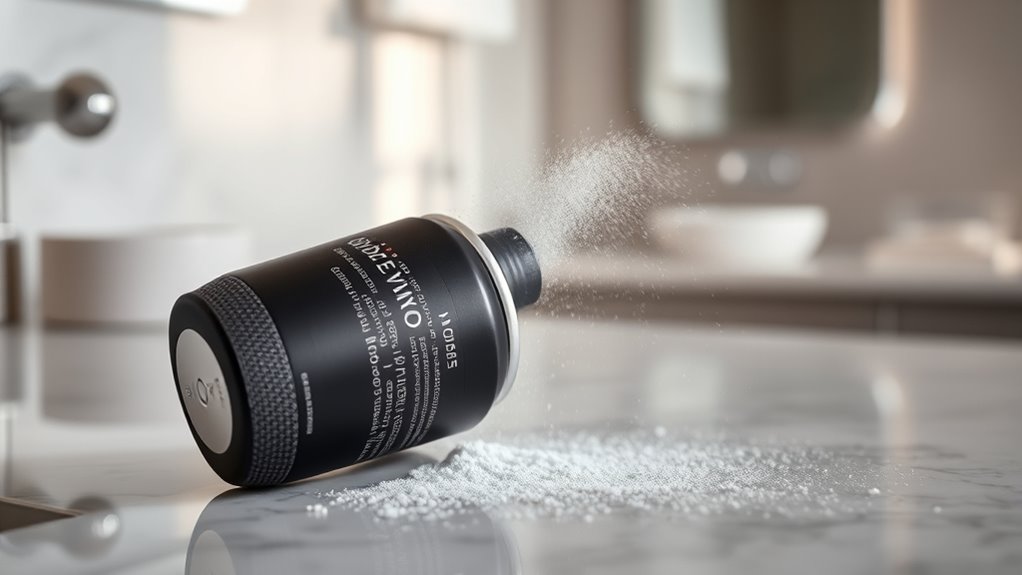
Dry shampoo can cause scalp irritation if used too often or if you have sensitive skin. It may also lead to hair buildup, which can weigh your hair down and clog follicles. Understanding these risks helps you decide how to use dry shampoo safely. Additionally, excessive use of dry shampoo can interfere with natural hair and scalp health, potentially affecting hair growth and overall cleanliness through automation’s role in business intelligence.
Potential Scalp Irritation
Although dry shampoo offers a convenient way to refresh your hair, it can sometimes cause scalp irritation if used excessively or improperly. Overuse may lead to scalp dryness, making your skin itchy or flaky. Ingredient sensitivity is another concern; some formulas contain fragrances or preservatives that can trigger allergic reactions or irritation, especially if you have sensitive skin. If you notice redness, itching, or discomfort after applying dry shampoo, it’s a sign to reduce use or switch to gentler options. Proper application—avoiding direct contact with your scalp and washing your hair regularly—can help minimize irritation. Remember, your scalp needs care, and understanding how dry shampoo interacts with your skin is key to avoiding potential irritation.
Hair Buildup Risks
Using dry shampoo frequently can lead to hair and scalp buildup, which may cause more harm than you realize. This buildup can affect your hair texture, making it feel greasy, weighed down, or brittle. Over time, it can also reduce styling flexibility, limiting your hair’s natural movement and volume.
To prevent issues, be mindful of:
- Clogged follicles: Excess residue can block hair follicles, leading to irritation or even hair loss.
- Scalp irritation: Buildup may trap dirt and oils, increasing the risk of inflammation or dandruff.
- Altered hair texture: Consistent buildup can make your hair appear dull, stiff, or greasy, affecting your styling options.
Use dry shampoo sparingly and maintain scalp hygiene for healthier hair.
Does Dry Shampoo Actually Make Your Hair Look Clean?
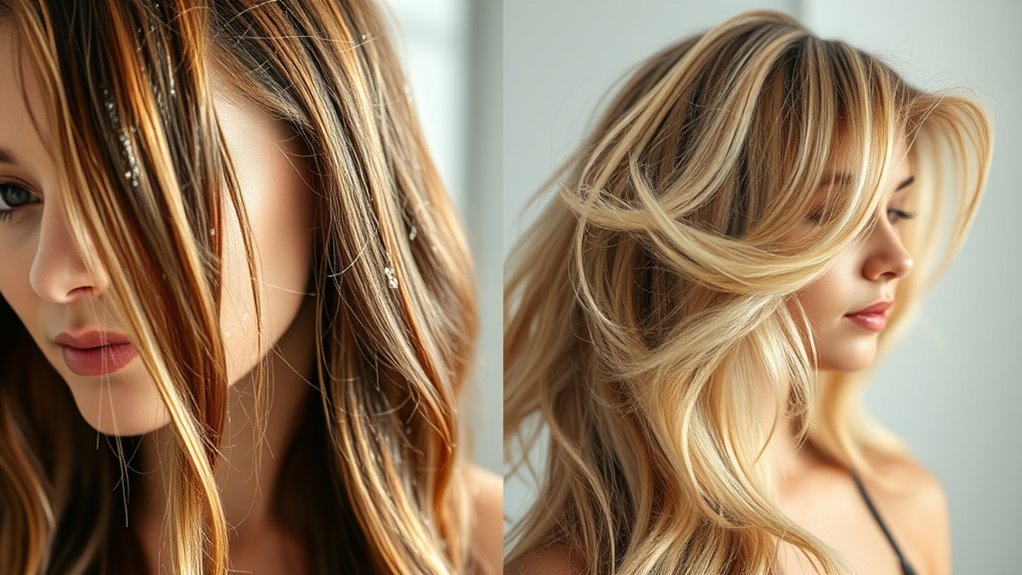
Have you ever wondered if dry shampoo truly makes your hair look clean? The answer depends on what you mean by “clean.” Dry shampoo absorbs excess oil and refreshes your scalp, which can make hair appear cleaner, especially around the roots. However, it doesn’t actually wash away dirt or sweat like traditional shampoo. If you have colored hair, using dry shampoo too often can cause buildup that dulls your hair color over time. Additionally, dry shampoo can affect your scalp’s pH balance, potentially leading to irritation if not used properly. While it offers a quick fix for greasy roots, it’s not a substitute for regular washing. So, it can make your hair look cleaner temporarily, but it doesn’t replace traditional cleaning methods.
What Are the Main Ingredients in Dry Shampoo?
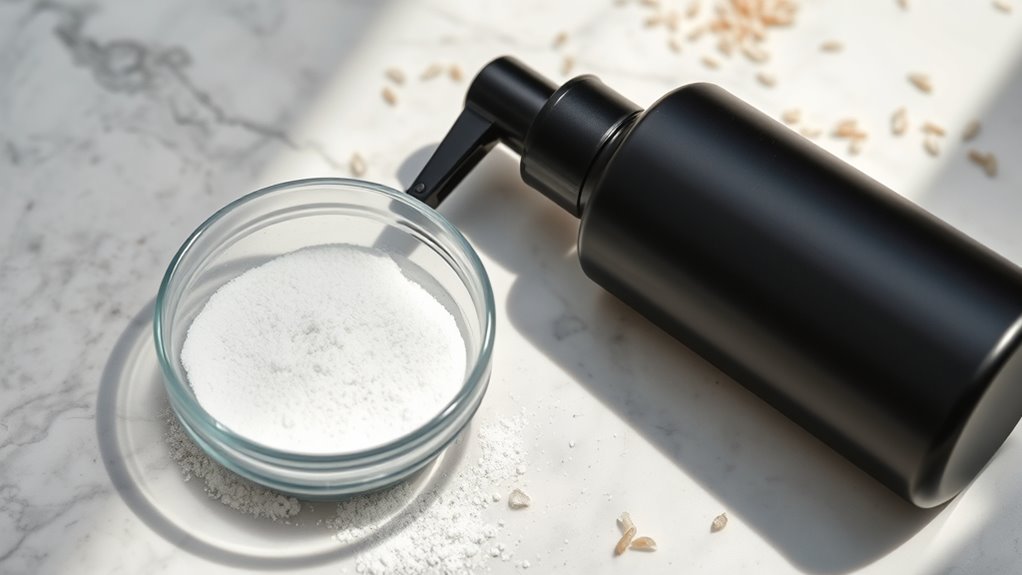
Dry shampoo works primarily by absorbing excess oil and grease from your scalp and hair, which helps improve its appearance between washes. The main ingredients typically include:
- Absorbent Powders: Such as cornstarch or rice starch, which soak up oils effectively.
- Propellants: Compressed gases that dispense the product evenly, often found in aerosol cans.
- Fragrance Agents: These add a fresh hair fragrance, masking odors and enhancing scent appeal. When comparing brands, look for those with natural or subtle fragrances to avoid overpowering smells.
Understanding these ingredients helps you make informed choices, especially when considering brand comparisons. Some brands incorporate additional ingredients like vitamins or botanical extracts for added benefits, but the core components remain consistent for oil absorption and scent.
How Often Should You Use Dry Shampoo?

Since overusing dry shampoo can lead to scalp buildup and potential irritation, it’s best to use it sparingly and only when necessary. How often you apply depends on your hair color and texture. If you have dark hair, frequent use may cause visible residue, so limit your applications to avoid a chalky look. For those with fine or oily hair, dry shampoo can be a quick fix, but avoid daily use to prevent dryness or damage. If you have curly or coarse hair, you might need it less often, as overuse can weigh down your curls or cause buildup. Ultimately, listen to your scalp and hair needs—use it enough to refresh your style, but not so much that it affects your hair’s health or appearance. Being aware of your cookie preferences can help you manage personalized hair care tips and product recommendations more effectively.
Frequently Asked Questions
Can Dry Shampoo Cause Scalp Buildup Over Time?
Yes, dry shampoo can cause scalp buildup over time if you don’t wash your hair regularly. Product accumulation may lead to scalp irritation, itchiness, or even clogged hair follicles. To prevent this, make sure you use dry shampoo sparingly and wash your hair thoroughly when needed. Proper scalp care helps avoid unwanted buildup, keeping your scalp healthy and free from irritation caused by excess product.
Does Dry Shampoo Contain Harmful Chemicals or Allergens?
Dry shampoo can contain chemical ingredients that may cause allergy concerns in some people. Always check the label for ingredients like perfumes, parabens, or sulfates, which could trigger reactions. If you have sensitive skin or known allergies, do a patch test first. Using products with natural or hypoallergenic formulas reduces risk. Being aware of chemical ingredients helps you choose safer options and minimizes allergy concerns when using dry shampoo regularly.
How Does Dry Shampoo Affect Hair Color or Highlights?
Think of dry shampoo as a double-edged sword; it can refresh your hair, but it might also cause hair color fading or highlight dulling over time. When you use it frequently, the buildup can weigh down color-treated strands, making highlights lose their vibrancy. To protect your hair color, apply dry shampoo carefully, focusing on roots and giving your hair breaks between uses. This way, you keep your color lively and your style fresh.
Is There an Ideal Time of Day to Apply Dry Shampoo?
You should apply dry shampoo in the morning or at the start of your day, which is ideal for freshening up hair and managing oil. Consider application timing based on your daily routine—if you exercise or work long hours, you might need it midday too. Be mindful of daily use considerations, as overuse can lead to product buildup. Applying at the right time helps maintain healthy hair and scalp.
Can Dry Shampoo Be Used on All Hair Types Effectively?
You can absolutely use dry shampoo on all hair types, and it’s a game-changer! Whether you have curly, straight, fine, or thick hair, your hair texture responds well when you choose the right product formulation. Some formulas are specially designed for textured hair, providing extra volume or moisture. Don’t worry—experimenting with different formulations guarantees you find the perfect dry shampoo for your unique hair, making bad hair days a thing of the past!
Conclusion
So next time you reach for dry shampoo, remember that science supports its oil-absorbing power, but it’s not a replacement for regular washing. Just like discovering a new favorite song, using it wisely can keep your hair looking fresh without harm. With a bit of knowledge, you’ll enjoy the convenience without the risks, making dry shampoo a helpful, unexpected companion in your hair routine. After all, sometimes the simplest solutions are the best surprises.

